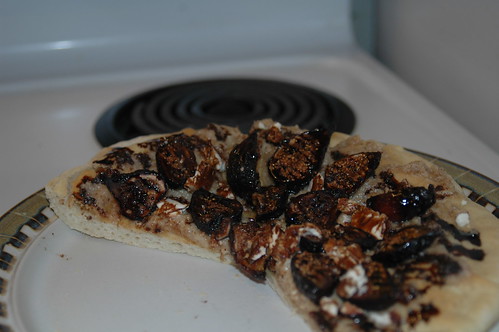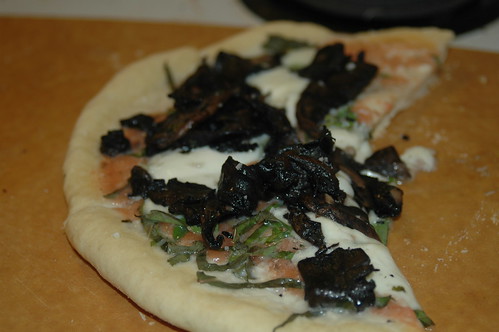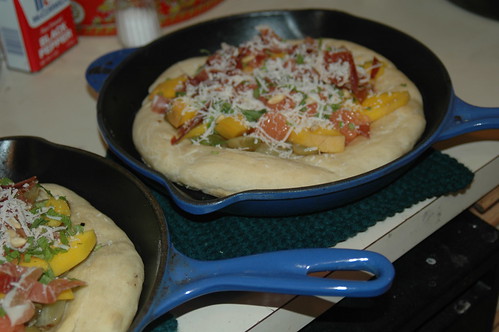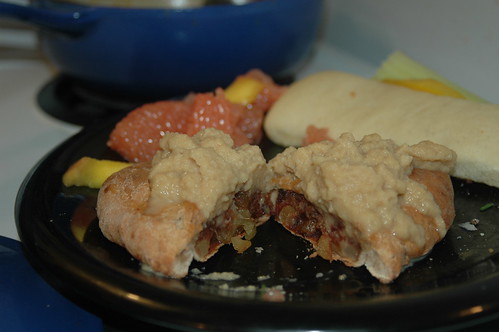Friday, February 27, 2015
Soondubu Jjigae
Friday, February 6, 2015
Fancy Breakfast...
Eggs Benedict on Potato Latkes with Braised Greens and Ham.
To begin - a few simple thoughts: making something like this is actually a bit timing-oriented so before starting a project one should read through the whole recipe and have a grasp of everything which is going on. Awareness of sequence is what allows 'us cooks' to get things done efficiently and serve hundreds more people than you without doing nearly as much work. This recipe has three basic parts: Potato Latkes, Braised Greens, and Hollandaise. In addition water needs heated for poaching and ham needs warmed up; all told if you try to do everything in one go you could have up to six different items cooking at the same time. I'm going to treat this dish as if you were preparing it all at once but the braised greens can be cooked in advance or omitted entirely if one were wont to do so.
Step one: Thinking ahead. For this step you will need:
3 saucepans
1 1/2 qts water
1/4 c cheap vinegar such as white or white wine
1/4 lb of butter
1/4 c good vinegar such as sherry or champagne
1 small shallot
2 bay leaves
1 tbls whole Black Peppercorn
First fill a two quart saucepan with one and a half quarts water and a quarter cup of cheap vinegar, place this on the rear large burner and heat to '5' or 'medium.' Add a quarter pound of butter to a different smaller saucepan and place that in the back small burner on '3' or 'medium low.' In a third even smaller saucepan measure a quarter cup of good vinegar such as sherry or champagne. Place this pan on the smallest front burner and set it to '3' or 'medium low,' this is a vinegar reduction for the hollandaise. With all of these going, slice a small shallot very quickly - it doesn't have to look nice and add it to the vinegar reduction along with a tablespoon of whole black peppercorns and two bay leaves. All told placing pans on the stove top, turning the heat on and slicing the shallot or other small onion should take you about five minutes, right? (Pro-tip: for better fuller flavor toast your peppercorns and bay leaves in the pan before adding the vinegar until fragrant - if you do this step you'll want to work on higher heat for the duration of the toasting, maybe '6' or 'medium-high' and toast for about five minutes or until fragrant. Add the vinegar and the shallot to the hot pan and reduce to '2' or 'low,' watch your nose as the vinegar hitting the hot pan will make a big, hard-to-inhale fragrance...)
Step two: Potato Latkes. For this step you will need:
1lb yukon or yellow potatoes (although any type will work these are best)
1/2 a large onion
1 bunch scallions
1 bunch cilantro
1 egg
1/4 c flour.
First take a large bowl and fill it with about two quarts hot tap water and add about two tablespoons of salt to that. Put your grater into the water bath and grate your potatoes and onion. Mix the grated stuff around in the water to get rid of the excess starch (this makes for crispier more white, fluffy hashbrowns). Taking one handful of hashbrowns at a time, squeeze as much water out as humanly possible before transferring to a new bowl. Slice the scallions and chop the cilantro coarsely and add to the dry hashbrowns along with the egg and the flour - mix to combine. In a heavy 10" cast-iron pan (pre-heated to '3.5' or 'medium-low') add two tablespoons of olive oil and one tablespoon of butter - coat the pan and spread the hashbrowns in an even layer in the pan pressing them down to form a solid crust. Cook for ten to fifteen minutes before flipping (unless you see or smell burning) and then cook for ten more minutes - perfect hashbrowns every time. (pro tip: after squeezing my browns dry I eat a couple of shreds to check for salt and to determine how much salt the browns will need to be tasty - don't be afraid to add more salt, as it makes things much better until it makes them worse)
Step three: Braised Greens. For this step you will need:
1 bunch of dinosaur Kale (stemmed and coarsely chopped)
2 cloves Garlic
1/4 tsp chili flakes
1/2 a Lemon
3 tbls Olive oil
1/4 c water
Place a 8"-10" saute pan on a large burner - at this point your vinegar should be significantly reduced and your butter should be melted and don't need to be on burners any more; place them in your cold oven to get them out of the way until you need them. Pre-heat your pan to '5' or 'medium;' it should smoke very faintly. Add your oil and garlic and toast until just colored (it is vital that the garlic does not get dark, that's part of why you need so much oil and will keep things from getting bitter). Add the chili when the garlic is nearly done and chase it into the pan with the Kale - this keeps the chili from over-toasting. Season kale with salt and pepper and a squeeze of lemon juice and then add water. Stir with a wooden spoon until the kale is tender but not mushy. The water should be entirely reduced. Taste for seasoning and remove kale from the hot pan.
Step four: Making the Hollandaise. For this step you will need:
2 Egg Yolks
1/4 lb clarified butter (which you already started and have in the oven)
2 tbls reduced vinegar (also in the oven - if it is too far reduced add water to re-hydrate, strained of shallot and spices)
1/8 tsp cayanne
1/2 tsp smoked Spanish Paprika - Picante (The Hungarian stuff can go to hell for all I'm concerned - it doesn't generally add any flavor. Don't take my word - try them side-by-side, you'll see I'm right)
1/4 tsp (or several grinds) Fresh Black Pepper.
1 tsp salt
A few drops of hot water.
Hollandaise is a bit tricky so I will try to walk you through it easily. You need a warm bowl, I use steel and keep it on the stove between the burners so that everything stays nice and comfortably warm - not hot. Hot will kill your hollandaise and so will cold. Add your egg yolks to the bowl and whisk them vigorously. Add the Cayanne, Paprika, Black Pepper, and hot water (tap water hot, not boiling) and whisk together. Then alternating back and forth add a little of the butter and then a little of the vinegar (remember that it is important that they are still warm or else your sauce will break, so if they are cool warm them gently), during the butter and vinegar process you need to whisk vigorously the whole time - you may want someone to help you with your additions so you don't have to do all the work by yourself. When hand whisking, add the butter and vinegar just a few drops at a time, before adding more it is vital to see that the butter has been thoroughly emulsified into the sauce. When you have finished adding all the butter and vinegar taste and add salt to taste. If the sauce seems too thick add a few drops of water, if it seems too thin let it cool and it will thicken because of the butter in it. If you want it spicier add a little more cayanne or tobasco or whatever hot sauce you have - anything works. If there is no vinegar bite to the sauce add a little more un-reduced vinegar to pick it up - this much fat needs the vinegar to cut through it, and make it refreshing. Think of Hollandaise as being like a Buerre Blanc (you haven't made that? - I'm sure that I will get to it soon because I've been craving Halibut en buerre blanc - recipe to follow).
Step five: Poaching eggs. For this step you will need eggs and your pan of boiling, vinegary water.
Crack eggs into the boiling water. The boil will stop when the eggs hit the water, wait for the boil to come back and then reduce the heat to a gentle simmer. The eggs should take two to three minutes to cook or until they are slightly firm but still give significantly when touched. Remove from water with a slotted spoon and reserve on a plate or bowl so that the water can drain off of them.
Step six: Finishing. For this step you will need:
Ham, bacon, tasso ham, cured pork belly, Pancetta, Proscuitto, whatever.
Take the latke (fancy hashbrown) out of the pan and divide it between plates. Put your thinly sliced porky-goodness into that pan which is now off the heat and let it warm gently for about thirty seconds on each side or until warm-through. Put the warm pork on the latke's and place braised greens on top of that followed by the poached eggs and then smothered in the secret sauce... I mean Hollandaise. You can probably figure out what to do with it at this point...
Sunday, August 9, 2009
Pizza Night
For the crusts, I highly recommend using the recipes from Peter Reinhart's "Crust and Crumb... They will be better than the crusts that I made way back when.
In order of appearance.
Fig Pizza:
- Fist-sized lump of dough
- Figs (about 4 per person)
- Chicken Stock
- Feta (as desired)
- Balsamic (500 ml makes about a 1/4 cup)
- 1/2 cup Walnuts
- 3 tbls Cream
- 2 tbls Parmasan shredded
- salt
- pepper
To Make:
For the Figs: to reconstitute the figs, simply place them in an appropriately sized sauce-pan, and fill to about three-quarters of the height of the figs with chicken stock. Reduce the stock over medium-high heat until the sauce is completely gone, but the bottom of the pan is not quite dry. For the salsa di Noci: combine Walnuts, Cream, and Parmesan in a blender. For the balsamic reduction measure out 2 cups (about 500ml) of balsamic vinegar and place in a sauce-pan; bring to medium-low heat (it should be steaming but not bubbling) and reduce until it is just thinner than honey - this should take about 3 hours. To finish: thinly spread the salsa di noci over the crust, cut the figs in half and spread them evenly over the crust with the feta, then from a squeeze bottle- apply the balsamic reduction. This is a very bold pizza and should probably be served last.
Cheese & Tomato (serves 2-3):
- Fist sized lump of dough
- 2 tomatos
- 4 oz Olive Oil
- Fresh Bufala Mozzarella (as Desired)
- 2 large Portobello Mushrooms, chopped
- Chicken Stock
- Basil (chiffonade)
To make:
Pre-heat oven to 450 degrees (have either a pizza stone or cast iron pan in the oven to help the pizza cook more evenly). Roll out (or throw the dough until you have roughly a ten inch crust (you can make it ahead of time and freeze it if you want. You can make it with more or less dough also depending on how thick a crust you want, just keep in mind the temperature and bake time). In a blender purée the tomatoes till smooth; force them through a fine mesh strainer and whip in the olive oil. In a medium saucepan place the portobellos and fill with chicken stock to 3/4 the height of the mushrooms; cover and reduce until the stock has been absorbed by the mushrooms/evaporated. Slice the cheese and arrange all the ingredients on the crust and bake in the oven for 10-15 minutes until the crust is crisp and golden brown.
Fruit Pizza:
- Fist Sized lump of dough
- 1/3 Mango, thinly sliced
- 1/2 grapefruit peeled and membranes removed
- About 20 Green Grapes
- 1 tbls Garlic
- 1 tbls Olive Oil
- 2 oz thinly sliced cured ham (such as Jamon Serreno or Prosciutto)
- Small Handful of Pinenuts
- Sprinkling of Parmesan
- Mint leaves (chiffonade) for garnish
To Make:
Pre-heat oven to 450 degrees. Roll out or throw crust to desired thickness. Sautée the grapes and garlic in olive oil until the garlic is golden and the grapes are soft. Arrange the Mango, Grapefruit, Grapes, and ham on the crust; sprinkle lightly with pinenuts and Parmesan and bake for 10-15 minutes until the crust is golden-brown and crisp. Garnish with mint
Dessert Calzone (four portions)
For the Crust (same as the others - but...):
- Liberal Nutmeg
- 1/2 tsp Cinnamon
For the Apple Sauce:
- 4 apples peeled, cored and chopped
- 2 tbls calvados
- 3 tbls Heavy (36%-40%) Whipping Cream
- 1 tbls sugar
For the Calzone Stuffing:
- 12 medjool dates
- 6 oz Sultanas
- 4 oz course chopped Macadamia nuts
- water
- 2 tbls sugar
To Make:
For the Apple Sauce: Blend the apples in blender with the cream, Calvados and sugar until smooth; pass through a fine mesh strainer and gently simmer for 20-30 minutes.
For the Calzone: Pre-heat oven to 350 degrees. Place the dates and sugar in a medium sauce-pan and fill with water to 3/4 the level of the dates; cook over medium-high heat until the water is nearly gone and add raisins - continue to cook until the water is gone but the bottom of the pan is not burned (the dates and raisins should be quite tender). Turn the dates and Sultanas out onto a cutting board and chop until moderately fine, then mix in the Macadamia nuts and divide the stuffing into four equal parts. Pull golf ball-sized pieces off of the dough and roll them out into thin circles. Place the stuffing in the dough and fold over, crimping the edges as if it were a pie. Bake in the oven for 30-40 minutes until the dough is crusty and the pies are hot through. let cool for 20 minutes then serve with applesauce either on the pie or on the side.
Cucumber Soup
- 4 large cucumbers - peeled and seeded
- 6 radishes - peeled
- Juice of one large Orange (or lime, possibly)
- 1 cup regular yogurt
- 3 tbls Cilantro
- 4 tbls Chicken Stock
- 1/2 cup Virgin Olive Oil
- Fresh ground black pepper - generously applied (1/2 tbls?)
- Salt to taste
combine all ingredients in a blender until smooth, then force through a fine strainer. Serve chilled.
Wednesday, July 8, 2009
The First Post that Nobody knows about because I didn't tell them...
So anyways, I have been experimenting with integral sauces (picture in your mind with me a stack of pork that is dripping with a rich red wine and cherry sauce...) and have discovered a whole new world of flavour that always matches the meat that I serve it with. These sauces will be taking an immediate effect in the actual FFC dinners because once I learn something I make every effort to apply it to everything I know - at least until I get tired of it; it can take a while for that to happen.
In other news, I will be posting the recipes and how-to guides for (ranging from some to all) of the meals so that if you are feeling quite ridiculous you can attempt (and with a little help from your friends - succeed) at making the stuff. I will be starting with the pizzas (yes I still remember roughly how to make them) and working my way through the most recent - don't expect much activity here until sometime mid-month, as I do not have the internet at my house until then.




















